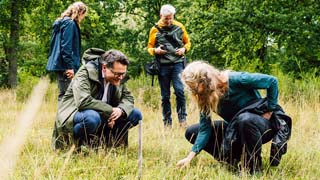Vienna and Berlin exchange expertise on urban nature restoration and biodiversity

Vienna is a pioneer in nature restoration and has implemented various biodiversity projects in the past. A current project involves restoring and protecting 90 hectares of ecologically valuable land in the former Breitenlee marshalling yard. Berlin has experience with similar projects, so Vienna's Executive City Councillor for Climate, Jürgen Czernohorszky, headed an expert delegation to Germany's largest city for inspiration.
When it comes to nature restoration projects, the two largest cities in the German speaking countries follow similar strategies. Berlin has already restored two former railway brownfield sites to their original natural state, and Vienna is planning to do the same at the Breitenlee site, a former marshalling yard in the city’s northeast. Now experts have met in Berlin to exchange experience and know-how in this field. A return visit is scheduled for late summer this year, as was agreed with Berlin's State Secretary for Climate Protection and the Environment, Britta Behrendt, during a reception at the Austrian embassy in Berlin.
Berlin: nature restoration based on dialogue
The first site visit took the delegation from Vienna to a biodiversity reserve on Pfaueninsel, an island in the Havel river, which offers ideal conditions to conserve rare species and reintroduce lost species to the area. In Berlin alone, 700 wild plant species are critically endangered by now.
Similar to the Schöneberger Südgelände nature reserve in Berlin, the project plans for Breitenlee in Vienna also provide for publicly accessible areas and paths. At Schöneberger Südgelände, viewing platforms allow visitors to observe nature and sheep, while signs provide information on the area and its history. The local art scene has also been included in the project; there is even a dedicated area for graffiti artists.
Another area the delegation visited was the park "am Gleisdreieck", which combines green spaces and forest-like areas. Remnants of its past function as a railway junction, such as old tracks and signalling systems, can be found throughout the park. Citizens' initiatives campaigned for the park's creation for years, and have now come to play a key part in the project. Local residents were involved in the planning and design process from the onset, which gave rise to an intensive dialogue process. Since 2014, an elected user advisory board has accompanied the ongoing development of the park.
Vienna - combining climate protection and quality of life
In addition to the Breitenlee area, Vienna has already implemented various nature restoration projects, such as the restoration of the Liesing brook in the south of the city, façade greening projects, or switching to permanent forest management to preserve urban woods and forests.
In 2022, the City of Vienna also launched a project called "Wiener Wäldchen" ("Vienna groves"). So far, five new groves of trees have been planted, contributing to urban biodiversity and cooling down the area thanks to natural plant evaporation. Vienna is generally committed to a particularly gentle and sustainable form of forestry. After all, woodland areas cannot adapt to future developments unless they are kept in a natural state with a high degree of biodiversity.
Chief Executive Office - European and International Affairs
Contact form
